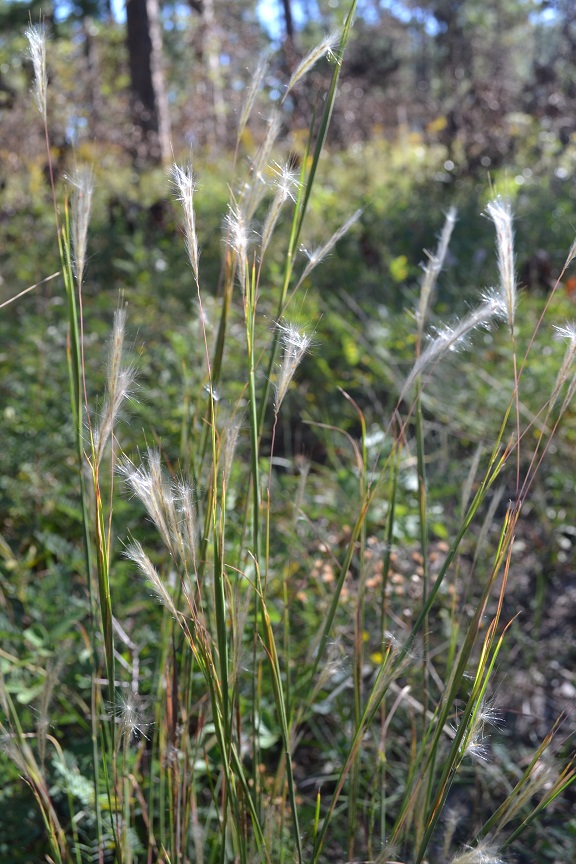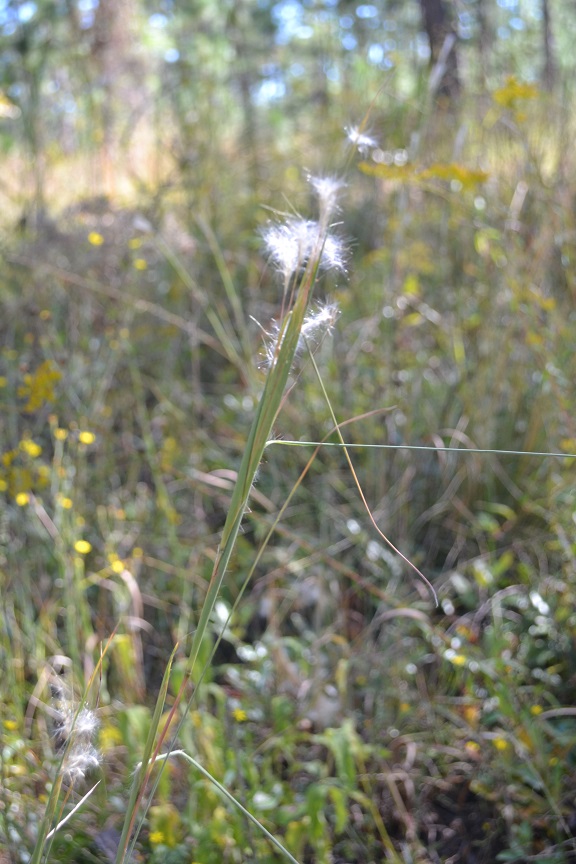Andropogon gyrans
| Andropogon gyrans | |
|---|---|

| |
| Photo by Kevin Robertson | |
| Scientific classification | |
| Kingdom: | Plantae |
| Division: | Magnoliophyta - Flowering plants |
| Class: | Liliopsida – Monocotyledons |
| Order: | Poales |
| Family: | Poaceae ⁄ Gramineae |
| Genus: | Andropogon |
| Species: | A. gyrans |
| Binomial name | |
| Andropogon gyrans Ashe | |

| |
| Natural range of Andropogon gyrans from USDA NRCS Plants Database. | |
Common name: Elliott's bluestem
Contents
Taxonomic notes
Synonyms: A. elliottii Chapman; A. elliottii; A. campyloracheus Nash; A. gyrans Ashe; A. gyrans var. gyrans; A. elliottii var. elliottii; A. elliottii var. gracilior Hackel; A. elliottii var. projectus Fernald & Griscom
Description
Distribution
Ecology
Habitat
Within the Coastal Plain this species occurs in a wide range of open habitat conditions, including frequently burned longleaf pine and shortleaf pine-oak-hickory communities,[1] longleaf pine and pine-turkey oak sandhills, Florida scrub communities, pine flatwoods, wet savannas, wet depressions within pinelands, seepage slopes (pitcher plant bogs), calcareous (rockland) slash pine flatwoods, dune swales, shrubby wet prairies, and open cypress swamps.[2][3] Soil conditions include deep sand Entisols, sandy loam Ultisols, sandy peat Spodosols, wet Histosols (peat). This species does well in open, semi shade, and semi open light conditions and grows in large clumps together.
Associated species include longleaf pine, slash pine, wiregrass, turkey oak, Aster adnatus, Sarracenia spp., Ludwigia, Bidens, Sacciolepis, Titi, sweetgum, yaupon, and others.[3]
Phenology
Flowers summer and fall.[4]
Seed bank and germination
In sandhill communities, it suffers from seed germination and radical growth inhibition by allelopathic scrub species during the beginning of the rainy season.[5][6]
Fire ecology
This species is commonly found in burned pine and oak woodlands.[3] Elliott and Vose (2005) initiated a single dormant season burn (low to moderate intensity fire) on a plot containing Andropogon gyrans to see if it would stimulate growth. Additional burning may be required to stimulate its growth and the growth of other bluestem-grasses.[1] Prescribed fire and pine straw harvesting both led to increases in herbaceous plant production (including A. gyrans).[2] It is most common in native communities with minimal soil disturbance. A. gyrans was among the species that responded positively to reduction of woody vegetation using triclopyr herbicide.[7] Following a November 28, 2015 burn, resprouts were noted 38 days after the fire.[8]
Conservation and management
Cultivation and restoration
Photo Gallery
References and notes
- ↑ 1.0 1.1 Elliott, K. J. and J. M. Vose (2005). "Effects of understory prescribed burning on shortleaf pine (Pinus echinata Mill.)/mixed-hardwood forests." Journal of the Torrey Botanical Society 132: 236-251.
- ↑ 2.0 2.1 Haywood, J. D. (2012). "Pine straw harvesting, fire, and fertilization affect understory vegetation within a Louisiana longleaf pine stand." Southern Journal of Applied Forestry 36: 130-135.
- ↑ 3.0 3.1 3.2 Florida State University Robert K. Godfrey Herbarium database. URL: http://herbarium.bio.fsu.edu. Last accessed: June 2014. Collectors: Robert K. Godfrey, Neal Morar, Sidney McDaniel , Loran C. Anderson, R. Kral, Ann F. Johnson, C.S. Campbell, John Morrill, O. Lakela, A.H. Curtiss, H.F. Lamp, R. E. Perdue, Jr., Austin Mast, Michael R. Jenkins, John G. Palis, J. M. Kane, Ed Keppner, Lisa Keppner, Angus Gholson, Wilson Baker, and A. F. Clewell. States and Counties: Florida: Wakulla, Gilchrist, Leon, Franklin, Calhoun, Liberty, Nassau, Bay, Jackson, Madison, Putnam, Hillsborough, Walton, Okaloosa, Duval, Highlands, Manatee, Clay, Monroe, Santa Rosa, and Jefferson. Georgia: Thomas, Grady, and Colquitt.
- ↑ http://www.namethatplant.net/plantdetail.shtml?plant=83
- ↑ Richardson, D. R. (1985). Allelopathic effects of species in the sand pine scrub of Florida (fire). Ecology. Ann Arbor, MI, University of South Florida. Ph.D.: 135.
- ↑ Richardson, D. R. and G. B. Williamson (1988). "Allelopathic effects of shrubs of the sand pine scrub on pines and grasses of the sandhills." Forest Science 34: 592-605.
- ↑ Miller, J. H., R. S. Boyd, et al. (1999). "Floristic diversity, stand structure, and composition 11 years after herbicide site preparation." Canadian Journal of Forest Research 29: 1073-1083.
- ↑ Observation by Edwin Bridges January 5, 2016, posted to Florida Flora and Ecosystematics Facebook Group January 6, 2016.
